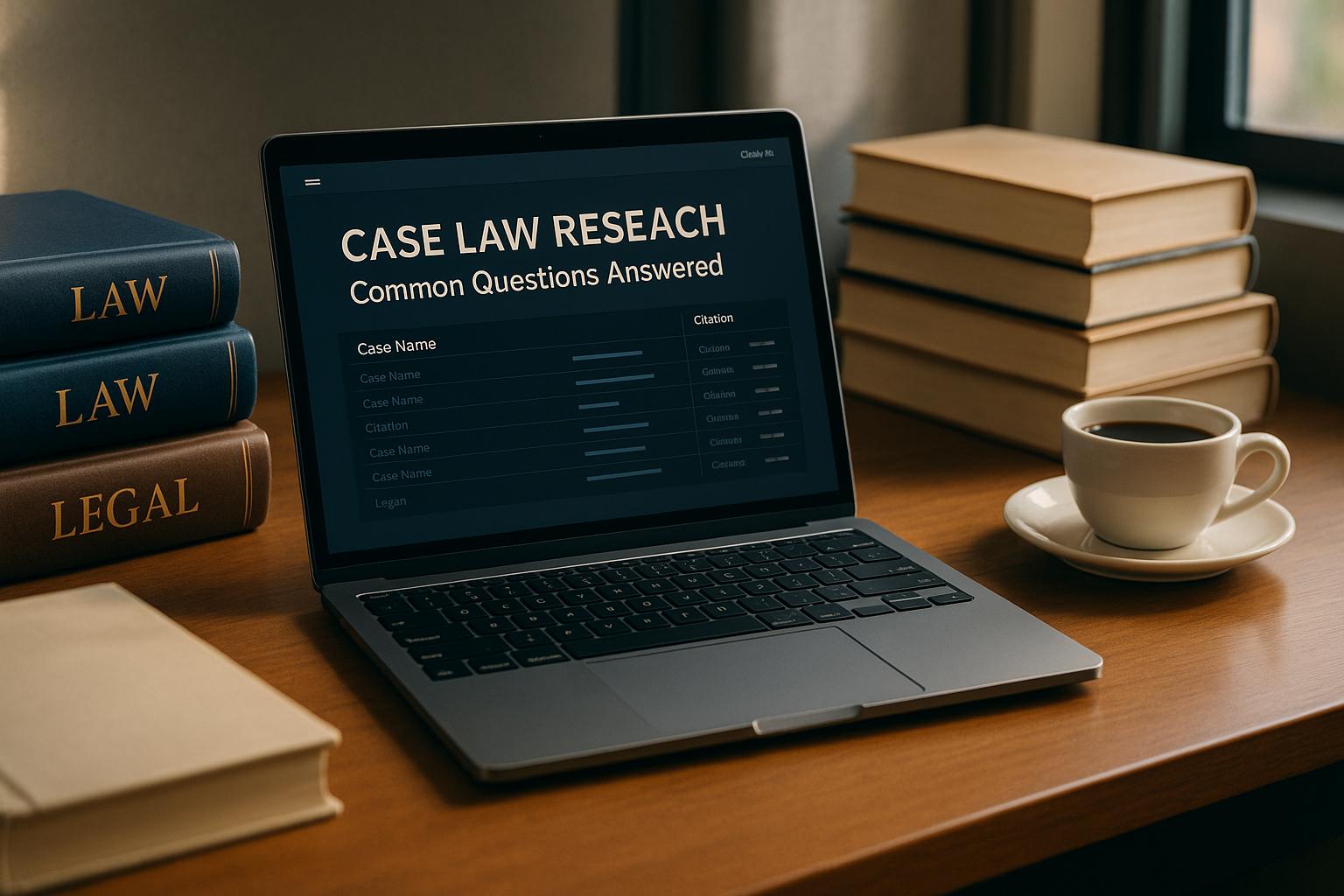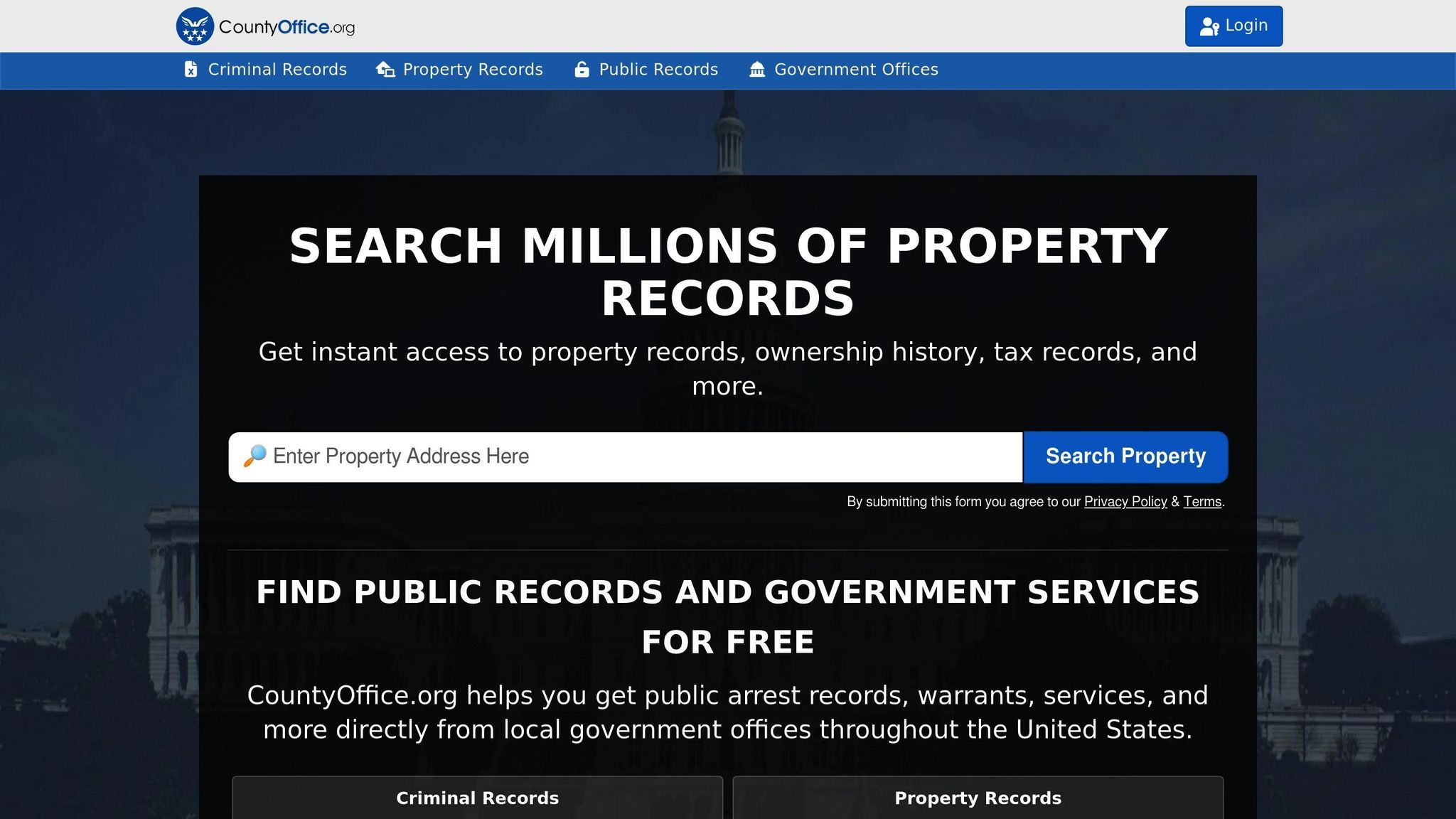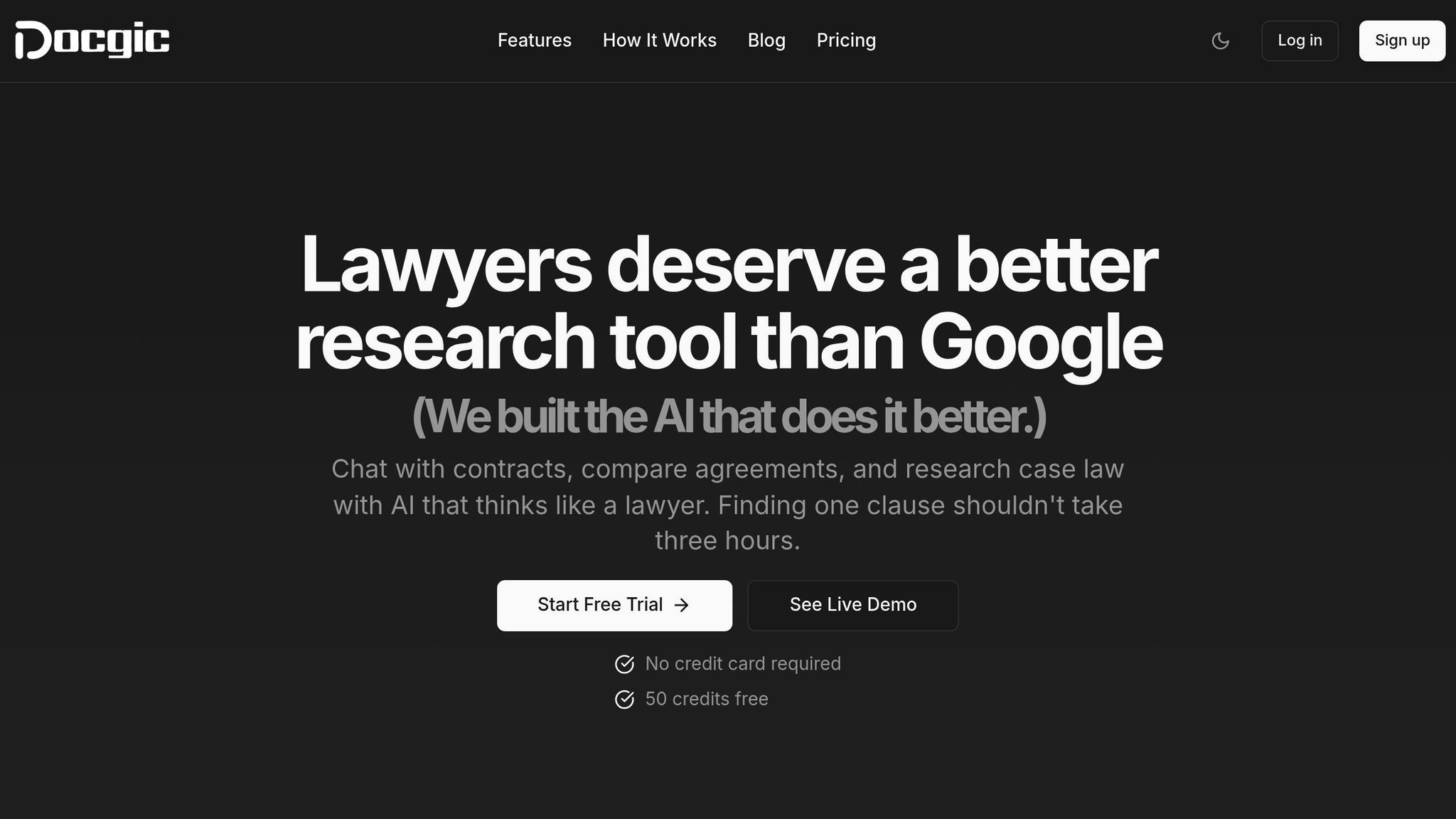Case Law Research: Common Questions Answered
Explore essential strategies for effective case law research, overcoming challenges, and leveraging AI tools to enhance legal practice.

Case Law Research: Common Questions Answered
Case law research is a cornerstone of legal practice in the U.S., where judicial decisions shape how laws are applied. Whether you're a law student or a seasoned attorney, knowing how to navigate case law effectively can save time and avoid costly mistakes. Here's what you need to know:
- Understanding Case Law: It refers to legal principles derived from court rulings, often guided by the doctrine of stare decisis (adhering to precedents).
- Key Challenges: Overwhelming data, verifying case authority, and navigating jurisdictional differences.
- Research Tips: Start with secondary sources, use citator tools to confirm validity, and organize findings meticulously.
- AI Tools Like Docgic: These platforms streamline research, validate cases, and manage multi-jurisdictional complexities.
How To Research Case Law? - CountyOffice.org

Common Challenges in Case Law Research
Faulty legal research is a significant issue, contributing to over 70% of legal errors. On top of that, 86% of legal professionals point to inefficiencies in the research process as a major concern. Tackling these challenges head-on is essential for building effective strategies.
Managing Information Overload
The sheer volume of legal data can overwhelm even the most experienced researchers. With thousands of new cases decided annually across federal and state courts, pinpointing the most relevant precedents can feel like searching for a needle in a haystack. Researchers often face the daunting task of combing through decades of decisions, which increases the risk of missing critical precedents or wasting valuable time. Tight deadlines only add to this pressure, forcing attorneys to juggle speed and accuracy.
"The most challenging part of legal research is to make sure that the case law uncovered is most relevant and authoritative to the matter on hand."
- David Reischer, Attorney & CEO of LegalAdvice.com Corp
To manage this flood of information, legal professionals are encouraged to adopt systematic research workflows, break tasks into smaller, more manageable steps, and use Boolean operators to refine search results. These methods can help cut through the noise and focus on what truly matters.
But beyond the sheer quantity of information, ensuring the validity of case law introduces another layer of complexity.
Confirming Case Authority
One of the biggest hurdles in legal research is verifying that cited cases are still valid and authoritative. Precedents can be overturned, reversed, or limited by subsequent rulings, making it critical to confirm a case’s current status. However, navigating citator tools can be tricky, and inconsistent results across different platforms often lead to conflicting information. This forces researchers to cross-check multiple reliable sources to ensure accuracy.
"Access to the best legal research tools is expensive, but in my experience, it's worth the investment because it's faster, more intuitive, and produces more relevant search results."
- Jillian Caires, Expert Business Attorney at Smith + Malek PLLC
To minimize errors, professionals should rely on trusted databases, cross-reference findings, and set up legal alerts for updates on relevant topics.
While confirming a case's authority is vital, conducting research across multiple jurisdictions adds another layer of difficulty.
Working Across Different Jurisdictions
Multi-jurisdictional research is often challenging because of the differences in legal practices, administrative procedures, and terminology between courts and states. Laws are shaped by the unique socio-political and economic factors of each jurisdiction, leading to significant variations.
"A major complicating factor in multi-jurisdictional court research is often the lack of common terminology and definitions to help researchers know whether they are, in fact, studying apples or some other type of fruit or something else entirely (maybe household furniture)."
- Paula Hannaford-Agor
This lack of standardized language can make it difficult to identify similar legal concepts across jurisdictions, sometimes rendering multi-state research ineffective. Often, separate investigations are needed for each region. Additionally, court operations data frequently requires extensive footnotes to explain how each state's practices differ.
Cost constraints further complicate matters for smaller firms. As Rebecca Ritchey, CEO of Sibus Law Group, APC, notes:
"The most common research challenge, in general, is access to resources to search for cases/statutes. So, solo or small firms do not often pay for Lexis or Westlaw [to] give attorneys access to large databases."
- Rebecca Ritchey
To navigate jurisdictional challenges, legal researchers should collaborate with experts familiar with specific regions. Conducting jurisdiction-specific research using guides, topical indices, and secondary sources often yields better results than attempting broad multi-state searches. Creating a glossary of key terms and organizing regulatory information by jurisdiction can also help streamline the process.
These issues - information overload, verifying authority, and navigating jurisdictional differences - underscore the need for a structured, focused approach to legal research.
Best Practices for Case Law Research
Having a structured approach to case law research can make your work both faster and more accurate. Below are strategies to address common challenges and build a reliable research process.
Begin with Secondary Sources
To tackle the overwhelming volume of legal information, start with trusted secondary sources. These resources help you get a clear picture of the legal framework, pinpoint essential terms, and identify key precedents without drowning in unrelated cases.
Start by gathering the basic facts of your case - who, what, why, when, where, and how. This groundwork helps you create targeted search terms and determine whether your research should focus on federal or state jurisdiction. With this clarity, secondary sources like legal encyclopedias, treatises, practice guides, and law journals become invaluable tools.
If you already have a statute or regulation in mind, use it as a starting point. It can guide you to relevant secondary sources and related case law. Similarly, if you have a specific case citation, review that case first to uncover additional resources and precedents.
Build a list of comprehensive search terms, including synonyms and alternative phrases, informed by your secondary research. This sets the stage for a more focused and productive search.
Once you’ve gathered insights from secondary sources, the next step is to confirm the validity of your findings using citator tools.
Use Citator Tools for Validation
Citator tools are essential for ensuring the cases you rely on are still valid. These tools track how cases have been treated over time, helping you avoid citing outdated or overturned precedents.
Citators work by compiling references from other primary and secondary sources that cite a specific case, showing whether it remains "good law." They also identify if a case has been overruled, whether related statutes have faced constitutional challenges, and provide details about procedural history, such as appeals.
Modern citators use symbols and flags to indicate a case's status. For example, a red flag usually means a case is no longer valid. Keep in mind that each platform has its own system, so results may vary.
If a case has received negative treatment, it doesn’t necessarily mean it’s irrelevant. Review those cases to understand the context and assess whether your precedent still holds weight, especially within your jurisdiction or higher courts.
Best practices for using citators include reviewing a case’s history for important details like pending appeals, cross-checking findings with official repositories, and staying updated on recent decisions or legislative changes that might affect your research.
Organize and Track Your Research
Once you’ve validated your cases, staying organized is key to avoiding redundant work and ensuring accuracy. Without a system in place, it’s easy to overlook important sources or waste time revisiting the same materials.
Maintain a research log to track your strategy, including databases used, search terms, and results. Organize findings by relevance, jurisdiction, and legal issue, noting the dates of verification and any negative treatment flags. Group cases into categories like "directly on point", "analogous", and "distinguishable", and prioritize controlling authority over persuasive authority.
To manage the overwhelming amount of information, break your research into smaller, focused tasks. Set clear goals for each session to make the process more manageable. Use consistent naming conventions for your files and organize them into clearly labeled folders for easy access and updates.
Regularly reviewing your organized materials can help you spot patterns or connections you may have missed earlier. This methodical approach not only simplifies your workflow but also improves the reliability and depth of your research.
sbb-itb-e7d4a5d
How Docgic Improves Case Law Research

Docgic builds on established research methods, using AI to tackle challenges like information overload, validating case authority, and navigating jurisdictional differences. By addressing these core hurdles, Docgic simplifies the often complex process of case law research through its tailored, AI-powered tools.
Key Features of Docgic
Docgic integrates AI with traditional legal research to offer a suite of tools designed specifically for legal professionals.
With instant case law research, users can quickly access a comprehensive analysis of relevant cases, statutes, and regulations. Unlike general search engines that overwhelm with excessive results, Docgic’s AI focuses on legal terminology and concepts, delivering precise answers tailored to your research needs.
The synthesis and analysis feature doesn’t just retrieve cases; it identifies relationships between precedents, helping users construct strong legal arguments. This is especially useful for navigating complex legal scenarios or working across multiple jurisdictions.
Docgic also provides citation-backed answers, ensuring that every piece of information is accompanied by direct references for easy verification. Automatic citation detection and metadata enrichment make it simpler to build well-supported legal arguments.
With cross-document analysis, users can spot inconsistencies between contracts and monitor changes across different document versions. This feature streamlines the review process for related cases and evolving legal precedents.
Finally, advanced analytics deliver insights into document patterns and workflow efficiency, helping legal professionals make data-driven decisions.
These features collectively enhance the efficiency and accuracy of legal research.
Benefits for Legal Professionals
Docgic significantly improves productivity, cutting document review time by 85%, reducing errors by 90%, and doubling billable hours. The platform uses supervised machine learning, which is more accurate than unsupervised approaches. Madeline Cohen, Bloomberg Law’s library relations director, highlights this advantage:
"Being able to analyze – that's the bread and butter of attorneys. That's what the best legal platforms do that regular generative AI doesn't."
Docgic also prioritizes legal-grade security, ensuring compliance with attorney-client privilege requirements through features like per-client document isolation. It supports multiple file formats, including PDF and DOCX, and keeps research results up to date with the latest legal developments.
Pricing and Plan Options
Docgic offers flexible pricing to meet the needs of different users.
| Plan | Price | Document Limit | Credits per Month | Key Features |
|---|---|---|---|---|
| Law Student | FREE | 10 documents | 50 credits | Document analysis, chat with documents, legal research, case law search, document organization |
| Lawyer | $29.99/month | 200 documents | 500 credits | Advanced document analysis, enhanced document comparison, precedent analysis, deposition analysis, priority support |
| Law Firm | $99.99/month | Unlimited documents | 2,000 credits | All Lawyer features plus custom integrations, extended data retention, dedicated support, enterprise-grade security |
The Law Student plan offers free access to essential tools, making it ideal for learning and mastering case law research basics. The Lawyer plan, priced at $29.99 per month, includes advanced features tailored for individual practitioners. For larger organizations, the Law Firm plan provides unlimited document storage and enterprise-level features for $99.99 per month.
Docgic’s credit-based system ensures flexibility, with credits refreshing monthly to accommodate varying research demands. This structure makes it easy to scale usage based on workload.
Key Takeaways
Review of Challenges and Solutions
Legal professionals often grapple with overwhelming amounts of information and the difficulty of verifying case authority - issues that can lead to costly research mistakes. As David Reischer, Attorney & CEO of LegalAdvice.com Corp., puts it:
"The most challenging part of legal research is to make sure that the case law uncovered is most relevant and authoritative to the matter on hand."
Navigating multiple jurisdictions adds another layer of difficulty, making it essential to organize cases by practice area for quick reference. Creating checklists of key sources and prioritizing them by authority and relevance can also help streamline the process.
These challenges highlight the need for tools like Docgic, designed to simplify and enhance legal research.
Why Choose Docgic
Docgic tackles these challenges head-on with AI-driven tools specifically designed for legal research and document analysis. It provides precise, citation-supported answers and helps uncover relationships between precedents through its synthesis and analysis capabilities. Additionally, its cross-document analysis feature identifies inconsistencies and tracks document revisions with ease.
For cost-conscious legal professionals, Docgic offers a free Law Student plan, making advanced tools accessible to those just starting their careers. By delivering faster and more targeted search results, Docgic represents a smart investment for anyone looking to improve their research efficiency.
Next Steps
Given these insights, it’s worth exploring Docgic’s plans to optimize your legal research process. With 42% of paralegals expressing a desire to improve their research skills, the free Law Student plan offers a valuable opportunity to experience instant case law research and analysis. For practicing attorneys, the Lawyer plan at $29.99/month provides advanced features to boost productivity, while law firms can benefit from unlimited document storage and enterprise-grade security with the Law Firm plan.
As Prosper Shaked, Personal Injury Attorney at The Law Offices of Prosper Shaked, notes:
"Successful legal research now has more to do with the attorney's ability to master the most advanced legal research service available to them at any given time than anything else."
Consider trying a demo or free trial of Docgic to see how AI-powered tools can revolutionize your legal practice.
FAQs
How does Docgic use AI to make case law research faster and more accurate?
Docgic employs AI technology to make case law research faster and more efficient, cutting down the time legal professionals spend analyzing large volumes of legal data. What used to take 17–28 hours can now be accomplished in just 3–6 hours, freeing up significant time for other priorities.
Through the use of advanced natural language processing, Docgic can interpret intricate legal texts with impressive accuracy. This reduces the likelihood of mistakes, allowing legal professionals to concentrate on strategic decisions while relying on the platform for dependable, data-backed insights to guide their work.
How can I effectively manage information overload while conducting legal research?
To tackle information overload during legal research, begin by defining clear goals and narrowing your focus to the most pertinent information. Divide your research into smaller, digestible tasks and concentrate on areas that have the greatest impact. A systematic approach to filtering and organizing your findings can also keep distractions at bay.
Leverage tools like AI-driven research platforms to streamline your workflow, saving both time and effort. Set time limits for your research sessions to prevent burnout, and practice selective reading by skipping over irrelevant or repetitive content. These steps can help you stay productive and manage the research process without feeling swamped.
How can legal professionals confirm that case law is valid and applicable across jurisdictions?
Legal professionals rely on citator tools to determine whether a case is still valid and authoritative. These tools reveal if a case has been overruled, affirmed, or continues to hold as good law, ensuring its relevance in legal arguments.
Equally important is verifying that the case comes from the correct jurisdiction and directly pertains to the legal issue at hand. It’s also worth assessing whether unpublished decisions carry any persuasive weight in that specific jurisdiction. By taking these steps, legal professionals can ensure they’re working with accurate and up-to-date case law.

